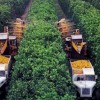Abstract
Mechanization has been the hallmark of American agriculture. Nearly 100 percent of the agronomic crops grown in the United States are plowed, planted, and harvested with mechanical equipment. Mechanical harvesting equipment for sweet oranges has been studied extensively since the 1970s and during the 2005/06 harvest season, trunk and canopy shakers harvested more than 36,000 acres of Florida citrus. Mechanically harvested citrus acreage, however, has decreased significantly since 2005. During the 2012/13 season, less than 9,000 acres were mechanically harvested (FDOC 2013). Nevertheless, development and adoption of mechanical harvesting technology is important to the long-term economic sustainability of the Florida orange juice processing industry. This 5-page fact sheet describing canopy shakers. Written by F.M. Roka, R.J. Ehsani, S.H. Futch, and B.R. Hyman, and published by the UF Department of Food and Resource Economics, August 2014.
References
Coppock, G.E. 1972. Properties of young and mature 'Valencia' oranges related to selective harvest by mechanical means. American Society of Agricultural and Biological Engineering 15(2):235-238. https://doi.org/10.13031/2013.37875
FDOC. 2013. Citrus Mechanical Harvesting Website. Florida Department of Citrus, Lakeland, FL. http://citrusmh.ifas.ufl.edu/index.asp?s=2&p=2.
Hedden, S.L., D.B. Churchill, and J.D. Whitney. 1988. Trunk shakers for citrus harvesting-part II: Tree growth, fruit yield and removal. Applied Engineering in Agriculture 4:102-106. https://doi.org/10.13031/2013.26589
Muraro, R.P. 2012. Estimated average picking, roadsiding, and hauling charges for Florida citrus, 2011-12 Season. Citrus Research and Education Center, University of Florida, Lake Alfred, FL. http://www.crec.ifas.ufl.edu/extension/economics/pdf/Estimated%20Average%20Picking%202011-12.pdf.
Roka, F.M., L.A. House, and K.R. Mosley. 2014. Mechanically harvesting sweet orange trees in Florida: Addressing grower concerns about production and long-term tree health. Gainesville: University of Florida Institute of Food and Agricultural Sciences. http://edis.ifas.ufl.edu/fe949.
Roka, F.M. and B.R. Hyman. 2013. Measuring productivity of citrus hand harvesters and assessing implications on harvest costs and mechanical harvesting development. Gainesville: University of Florida Institute of Food and Agricultural Sciences. http://edis.ifas.ufl.edu/fe933. https://doi.org/10.32473/edis-fe933-2013
Roka, F.M., R.J. Ehsani, S.H. Futch, and B.R. Hyman. 2014. Mechanical harvesting systems-trunk shakers. Gainesville: University of Florida Institute of Food and Agricultural Sciences. http://edis.ifas.ufl.edu/fe950.
UF/IFAS. Citrus Mechanical Harvesting Website: http://citrusMH.ifas.ufl.edu.
Whitney, J.D. 2003. Trunk shaker and abscission chemical effects on yields, fruit removal, and growth of orange trees. Proceedings of the Florida State Horticultural Society 116:230-235.

